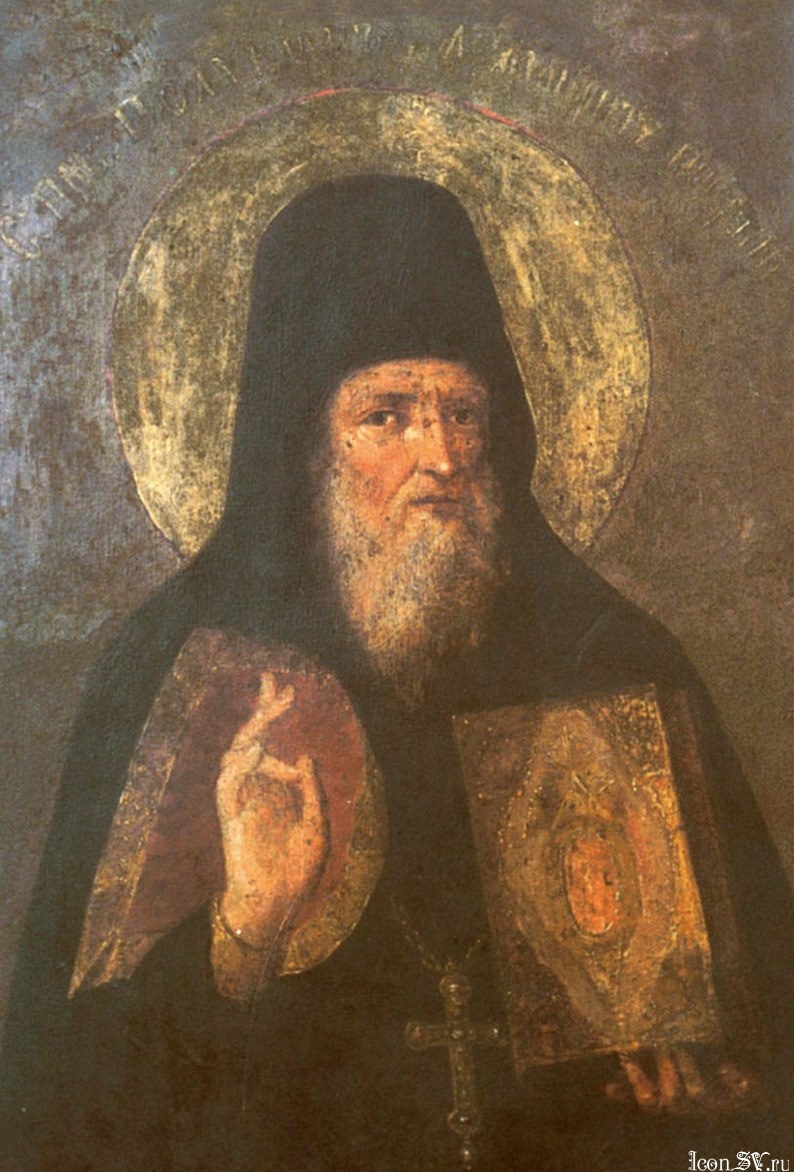Polycarp, archimandrite of the Kiev Caves, venerable (Near Caves)
Dates of commemoration
(Church calendar - Feb 27) Synaxis of all Venerable Fathers of the Kiev Caves (movable feast on the 2nd Sunday of the Great Lent)
(Church calendar - Jul 15) Synaxis of All Saints of Kiev
(Church calendar - Jul 24) Day of repose (1182)
(Church calendar - Sep 28) Synaxis of the Saints of the Kievan Caves Monastery, venerated in the near caves of Venerable Anthony
Life
Saint Polycarp the Archimandrite entered the Kiev Caves Monastery, where he received monastic tonsure and struggled for the salvation of his soul.
Soon Polycarp (whose name means “much fruit”) began to bear fruits of repentance and virtue. His relative Saint Simon (May 10), who became Bishop of Vladimir and Suzdal, planted the seeds which Saint Polycarp developed. As the holy bishop taught Polycarp the principles of the spiritual life, the two became increasingly united in spirit, just as they were related by blood.
When Saint Simon left the Monastery of the Caves to assume his hierarchal responsibilities in Vladimir, he took Polycarp with him. Saint Polycarp wrote down the stories that Saint Simeon told him of the God-pleasing ascetics of the Kiev Caves so that others might also benefit from them. Therefore, he is also known as Saint Polycarp the Hagiologist. Although Saint Polycarp returned to the monastery, he always tried to live according to Saint Simeon’s instructions.
After the repose of Igumen Akindynus, the brethren chose Polycarp to succeed him as the Superior of the Lavra. He proved to be a skilled guide for the brethren in their struggle for salvation, and also for those outside the monastery.
The Great Prince Rostislav was one of many who profited from the teaching of Saint Polycarp, and asked that he be allowed to become a monk. The saint told him, “God has appointed you to stand for the truth, to judge with justice, and to stand firmly before the Cross.”
Rostislav answered, “Holy Father, one cannot be a prince in this world without falling into sin. I am already exhausted and weakened by daily cares and labors. Now in my old age I would like to serve God and emulate those who have followed the narrow and sorrowful path and received the Kingdom of Heaven. I have heard of how Constantine (May 21), great among kings, appeared to a certain Elder and said, ‘If I had known what glory the monks receive in heaven... I would have taken off my crown and royal purple, and replaced them with the monastic garb’.”
Saint Polycarp told him, “If you desire this from your heart, then may it be God’s will.”
However, as the prince was passing through Smolensk, he fell ill and asked to be taken home to Kiev. Seeing how weak he was, his sister Rogneda urged him to remain in Smolensk and be buried in the church they had built there.
Rostislav would not accept this suggestion. He said, “If I do not make it back to Kiev, then let me be placed in the church my father built in the Monastery of Saint Theodore. If God delivers me from this illness and grants me health, then I vow to become a monk at the Monastery of the Caves under Polycarp.”
As he lay at death’s door, Rostislav said to the priest Simeon, “You must answer before God since you hindered me from being tonsured by the holy one in the Caves Monastery, for I truly desired that. May the Lord not count it as a sin that I did not fulfill this.”
Saint Polycarp went to the Lord on July 24, 1182. After this, no successor was chosen for a long time. Although there were many worthy Elders in the Lavra, they all declined the office of igumen out of humility. The brethren realized that they could not remain for long without a shepherd. They assembled in the church and prayed to Saints Anthony and Theodosius and Saint Polycarp to help them find someone worthy to take his place.
Then a voice was heard saying, “Let us go to the priest Basil in Schekovitsa. Let him be our Superior and rule the monastery in the monastic rank.”
The monks went to the widowed priest Basil and asked him to be their Superior, but he refused for a long time. After many entreaties, he finally agreed and went with them to the monastery. He was tonsured as a monk and installed as igumen by Metropolitan Nicephorus of Kiev, Bishops Laurence of Turov and Nicholas of Polotsk. Igumen Basil proved to be a model of virtues and a worthy successor to Saint Polycarp.
Source:
Holy relic type
unless specified otherwise below, "holy relic" means a fragment of a bone of the saint
1. Holy relic
2. Holy relic
Location of the holy relic in the Cathedral:
1. North kliros, reliquary #5
2. Relics cabinet in the Altar sacristy, reliquary #9
Troparion
Тропарь преподобного Поликарпа, архимандрита Печерского
глас 4
Тезоименит званию твоему,/ яко многоплодное древо,/ насажден сый во обители Божия Матере,/ многая и чудная тщанием твоим исправления показавый,/ мудре Поликарпе,/ моли Христа Бога о нас,/ яко да и мы, многия плоды добродетелей Ему принесше, спасемся.
Kontakion
Кондак преподобного Поликарпа, архимандрита Печерского
глас 8
Яко преподобным Печерским совсельника/ и житий их в себе делом и писанием изобразителя неложна,/ вкупе же славы Небесныя с теми общника явльшагося,/ приидите, вернии, песньми священными преподобнаго Поликарпа ублажим, зовуще:/ радуйся, архимандритов Печерских похвало.






